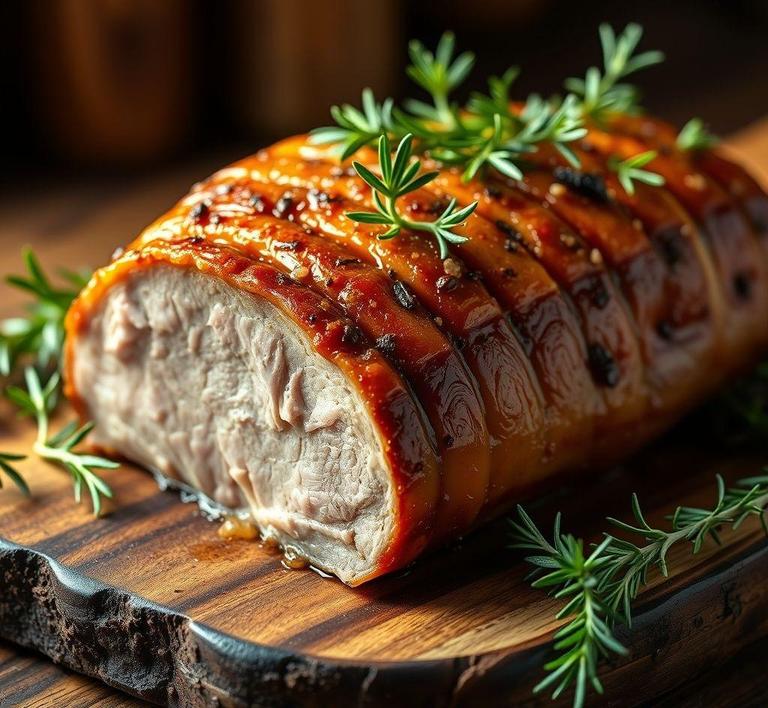So, you’ve got some leftover pork loin and you’re wondering if you can refreeze it for later? The good news is, yes, you can! Refreezing pork loin can help you make the most of your meal prep and avoid food waste, but there are a few things to keep in mind to ensure the meat stays safe and delicious. In this guide, we’ll walk you through the best practices for refreezing pork loin, including how to properly store it, how long it can stay frozen, and the key steps to take for keeping that tender, juicy flavor intact. Let’s dive in and make sure your pork loin is ready for another round in the freezer!
Can You Refreeze Pork Loin?

When it comes to refreezing meat, including pork loin, the question often arises: is it safe and will it affect the quality of the meat? The simple answer is: yes, you can refreeze pork loin, but with certain conditions. Understanding these conditions is crucial to maintaining food safety and preserving the quality of your pork loin.
Pork loin, like other meats, can technically be refrozen if it has been handled properly during the thawing process. The critical point here is that meat should only be refrozen if it has thawed in the refrigerator and has not been left at room temperature for too long. If pork loin has been defrosted in the microwave or in warm water, it is advised to cook it before refreezing, as this could introduce bacteria that might not be destroyed by freezing.
A key thing to note is that refreezing meat can increase the risk of bacterial growth if the meat has not been kept at a safe temperature, typically below 40°F (4°C). Once pork loin enters the "danger zone" of temperatures between 40°F and 140°F, bacteria can multiply rapidly. So, if you’ve thawed your pork loin improperly, refreezing is not safe.
Another important factor to consider is the overall quality of the meat. Refreezing can impact the texture, flavor, and moisture retention in the pork loin. Let’s delve into the details of what happens during the process.
How To Refreeze Pork Loin?
Refreezing pork loin requires following a few simple but important steps to ensure food safety and quality retention. Here’s how to do it right:
-
Thaw in the Refrigerator
The first step in properly refreezing pork loin is to thaw it safely. Always thaw pork loin in the refrigerator, not on the counter or in warm water. This helps to keep the meat at a safe temperature as it defrosts. Pork loin can take anywhere from 12 to 24 hours to thaw, depending on the size, so plan ahead. Avoid thawing at room temperature because bacteria can grow quickly between 40°F and 140°F.
-
Inspect the Meat
Before refreezing, make sure the pork loin has not been out of the refrigerator for too long. If it has been left out for more than two hours (or one hour if the room is over 90°F), it’s not safe to refreeze. Additionally, check for any signs of spoilage, such as an off smell, discoloration, or sliminess.
-
Wrap Properly for Refreezing
To preserve the flavor and texture of your pork loin during the refreezing process, wrap it tightly in freezer-safe packaging. Use heavy-duty plastic wrap, aluminum foil, or a vacuum-seal bag to minimize exposure to air, which can lead to freezer burn. If you use regular plastic wrap, you might want to double-wrap the pork loin or place it in a freezer-safe bag for an extra layer of protection.
-
Label and Date the Packaging
Always label the package with the date that you froze the pork loin. This helps you track how long it’s been in the freezer and ensures you use it within a safe timeframe. Pork loin, when refrozen, should be used within 3 to 4 months for optimal taste and quality.
-
Freeze at 0°F (-18°C)
Once wrapped properly, place the pork loin in the coldest part of your freezer. Freezing the meat at a steady 0°F (-18°C) will halt the growth of any bacteria and preserve its texture and flavor as much as possible.
Quality Impact
Refreezing pork loin can have some noticeable effects on its texture, flavor, and moisture retention. Here’s a closer look at what you can expect in terms of quality after refreezing:
-
Texture
One of the most significant impacts of refreezing pork loin is the change in texture. When meat freezes, the water inside the cells forms ice crystals. These ice crystals can rupture the cell walls, leading to a loss of moisture when the meat is thawed. Each time meat is frozen and thawed, the damage to the cell structure increases, resulting in a drier, tougher texture. This is especially true for lean cuts like pork loin, which don’t have as much fat to retain moisture compared to fattier cuts like pork shoulder.
-
Flavor
Flavor loss is another concern when refreezing pork loin. Freezer burn, which occurs when meat is exposed to air during the freezing process, can cause it to develop a bland, slightly metallic taste. While vacuum-sealing helps mitigate this risk, the longer pork loin is stored in the freezer, the more likely its natural flavors will diminish. Refrozen meat can also lose its characteristic tenderness and juiciness, leading to a less enjoyable eating experience.
-
Moisture Loss
Refreezing pork loin will inevitably result in some moisture loss, but the extent of this depends on how well it was packaged and how many times it’s been frozen. The more air exposure the meat has, the more likely it is to dry out. For example, vacuum-sealed pork loin is less prone to drying out compared to a cut stored in regular plastic wrap. It’s best to cook refrozen pork loin in moist preparations, like slow-roasting, braising, or making stews, to counteract the loss of moisture.
-
Nutritional Value
While refreezing pork loin doesn’t drastically affect its nutritional content, it might cause slight changes in protein structure and nutrient availability. These changes are minor, but if you’re looking to preserve the full nutritional benefits of fresh pork loin, it’s best to avoid refreezing as much as possible.
Refreezing pork loin is not inherently dangerous, but it does come with risks in terms of both food safety and quality. If the pork loin has been thawed properly in the refrigerator and hasn’t been exposed to temperatures above 40°F for an extended period, refreezing is generally safe. However, the process can significantly impact the texture, moisture, and flavor of the meat.
To minimize quality degradation, it’s important to wrap the pork loin tightly, store it at a proper freezing temperature, and avoid keeping it in the freezer for too long. Refrozen pork loin may not have the same juicy, tender qualities as fresh pork, but with the right cooking methods, it can still make for a flavorful and satisfying meal.
In the end, while it’s perfectly fine to refreeze pork loin under the right conditions, for the best quality, try to cook it after thawing, and consume it within a reasonable time frame. If you’re unsure whether you’ll use the pork loin in time, it’s better to cook it first and then refreeze the cooked meat, as this helps retain more moisture and flavor.
Is It Safe To Refreeze Pork Loin?
Refreezing pork loin-like any other type of meat-can be a bit of a gray area in terms of food safety. The general rule is that once meat has been thawed, it should either be cooked or eaten within a certain period. However, the decision to refreeze pork loin is largely contingent on how it was thawed, how long it’s been left out, and whether it’s been properly handled in the first place.
Thawing Method: The first factor to consider is how the pork loin was thawed initially. If it was thawed safely in the fridge, you can generally refreeze it without much concern. The refrigerator keeps the meat at a consistent, safe temperature, reducing the risk of bacterial growth. However, if the pork loin was thawed using methods like cold water or microwave thawing, refreezing is not recommended. Both of these methods cause the meat to reach temperatures that are ideal for bacterial growth, and refreezing it could lead to the multiplication of harmful pathogens, even if the meat is cooked later.
Quality Considerations: Even though it’s safe to refreeze pork loin under the right conditions, you should also consider the effect on the meat’s quality. Refreezing meat can lead to a loss of moisture, which may result in a drier texture and changes in flavor. This is especially true when pork is refrozen more than once. Each cycle of freezing and thawing breaks down cellular structures, causing a loss of tenderness, juiciness, and overall appeal.
In summary, it’s not inherently unsafe to refreeze pork loin if it was thawed properly, but there are risks associated with both the safety and the quality of the meat. Understanding these nuances will help you make informed decisions when handling pork loin and other types of meat.
Signs That Pork Loin Should Not Be Refrozen
While refreezing pork loin is sometimes safe, there are clear indicators that suggest it’s best to avoid doing so. If you notice any of the following signs, it’s likely that the pork loin should be discarded rather than refrozen:
- Foul or Sour Odor: If your pork loin has developed a sour, rancid, or off smell, it’s a clear sign that the meat has begun to spoil. Odor is one of the most reliable indicators of bacterial growth or decomposition, and once it’s present, the pork is no longer safe to eat-even if cooked. It’s best to discard the meat rather than attempt to refreeze or cook it.
- Slimy or Sticky Texture: Fresh pork loin should have a smooth, slightly firm texture. If it feels slimy or sticky to the touch after thawing, it’s an indication that the meat has been exposed to bacteria. This slimy texture occurs as a result of bacterial growth, which can proliferate even in cold environments.
- Discoloration or Grayish Tint: While pork loin can naturally change color from a pale pink to a slightly darker hue during the freezing and thawing process, if you notice any unusual darkening or the development of grayish or brown patches, this is a sign that the meat is starting to spoil. These color changes usually indicate oxidation or exposure to air, which can lead to foodborne illness if consumed.
- Freezer Burn: While freezer burn itself doesn’t make meat dangerous to eat, it does affect the quality of the pork loin. If the surface of the meat is covered in dry, grayish-brown spots and feels tough or leathery, it’s a sign of freezer burn. Freezing and refreezing exacerbate this problem, leading to further moisture loss and diminished flavor. If freezer burn is extensive, you may want to avoid refreezing the meat.
- Excessive Thawing Time: If the pork loin was thawed at room temperature for more than two hours (or one hour in hotter environments), bacteria may have proliferated. If the meat was left out for an extended period and didn’t remain at a safe temperature (below 40°F or 4°C), it should not be refrozen.
If any of these warning signs are present, it’s better to be safe than sorry-discard the pork loin and avoid risking foodborne illness.
Common Refreezing Mistakes
Refreezing pork loin might seem like a simple task, but there are several common mistakes that can compromise both the safety and quality of the meat. Avoid these pitfalls to ensure that you’re handling your pork loin correctly:
- Thawing at Room Temperature: One of the most common mistakes people make is leaving meat out at room temperature to thaw. While it’s tempting to rush the process, this is one of the most unsafe practices. Meat should always be thawed in the refrigerator, in cold water, or in the microwave to maintain a safe temperature. Thawing at room temperature can cause bacteria to multiply rapidly, and even if the pork is refrozen, it may not be safe to eat.
- Refreezing Multiple Times: Every time you freeze and thaw pork loin, you’re altering its texture and moisture content. Repeated cycles of freezing and thawing can make the meat dry, tough, and less flavorful. It can also increase the risk of bacterial contamination. Limit the number of times you freeze and thaw meat, and avoid refreezing if you’re unsure about its safety or quality.
- Not Using Proper Packaging: If you’re refreezing pork loin, it’s essential to package it well to prevent freezer burn. If the pork is exposed to air or moisture, it will dry out and lose its flavor. Make sure to wrap it tightly in plastic wrap, foil, or place it in a vacuum-sealed bag to protect the meat during the freezing process. The packaging should prevent air from reaching the surface of the meat and help preserve its quality.
- Not Cooking Before Refreezing: If you’ve already cooked the pork loin and have leftovers, it’s best to either eat or cook the remaining meat immediately. If you don’t plan to eat it soon, you can safely freeze cooked pork. However, if you plan to cook it again before freezing, ensure that it’s done thoroughly. Refreezing cooked pork without properly cooking it can lead to uneven heating and bacterial growth.
- Inconsistent Freezing Temperatures: If your freezer isn’t maintaining a consistent temperature below 0°F (-18°C), refreezing pork loin may be risky. A freezer that frequently fluctuates between freezing and thawing temperatures can cause the meat to go through cycles of partially thawed and refrozen, which increases the risk of bacterial growth and degradation of the pork’s quality. Make sure your freezer is working properly to avoid this issue.
Tips And Tricks
To ensure safe and effective refreezing of pork loin, here are some valuable tips and tricks:
- Freeze in Portions: Instead of freezing a large pork loin whole, cut it into smaller portions that can be thawed and used as needed. This way, you only defrost what you plan to use, minimizing waste and reducing the need to refreeze any leftover meat.
- Use a Meat Thermometer: To be sure that pork is fully cooked after thawing, use a meat thermometer to check the internal temperature. Pork loin should reach an internal temperature of at least 145°F (63°C) for safety. Cooking the pork to the right temperature ensures that it’s safe to eat, especially after refreezing.
- Label Packages: When freezing pork loin, always label the packaging with the date it was frozen. This will help you keep track of how long the pork has been stored and reduce the likelihood of eating meat that’s past its prime. It also ensures that you don’t accidentally refreeze something that has already been thawed too many times.
- Seal Air Out: Invest in a vacuum sealer if you plan to freeze pork regularly. A vacuum-sealed bag will keep air out, preserving the quality and flavor of the meat for longer periods. This also helps prevent freezer burn and keeps the pork tender and juicy.
- Thaw Slowly: When you’re ready to use frozen pork, always thaw it in the refrigerator overnight. Thawing meat slowly at a safe temperature reduces the risk of bacterial growth. Don’t attempt to speed up the thawing process by leaving it on the counter or using hot water.
Conclusion
Refreezing pork loin can be done safely, but it requires careful attention to food safety practices and quality preservation. Always consider how the pork was thawed, how long it’s been stored, and whether there are any signs of spoilage. While refreezing is generally safe if done right, it can affect the meat’s texture and flavor. To avoid common mistakes, take precautions by properly packaging, labeling, and thawing the meat. In the end, maintaining a consistent freezing temperature, checking for any signs of spoilage, and being mindful of your handling practices will ensure that your pork loin stays safe to eat and maintains its best quality.


